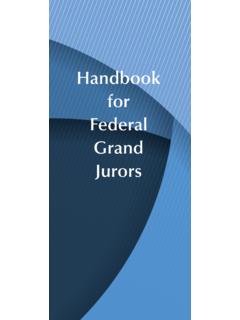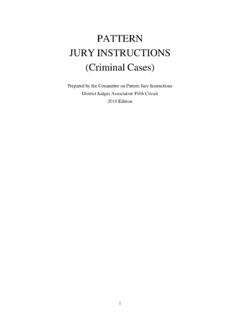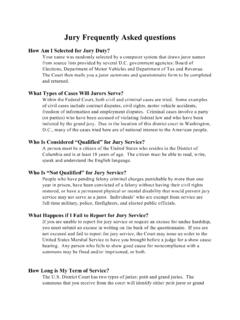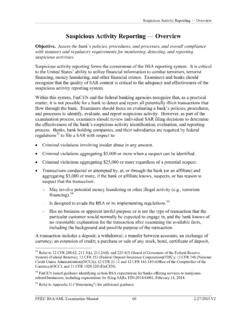Transcription of Instructions for Civil Rights Claims Under Section 1983 ...
1 1 Last updated October 2014 Instructions for Civil Rights Claims Under Section 1983 1 2 3 Numbering of Section 1983 Instructions 4 5 Section 1983 Introductory Instruction 6 7 Section 1983 Burden of Proof 8 9 Section 1983 Elements of Claim 10 11 Section 1983 Action Under Color of State Law 12 13 Section 1983 Action Under Color of State Law Is Not in Dispute 14 15 Section 1983 Determining When an Official Acted Under Color of State Law 16 17 Section 1983 Determining Whether a Private Person Conspired with a State 18 Official 19 20 Section 1983 Deprivation of a Federal Right 21 22 Section 1983 Liability in Connection with the Actions of Another 23 24 Section 1983 Supervisory Officials 25 26 Section 1983 Failure to Intervene 27 28 Section 1983 Municipalities General Instruction 29 30 Section 1983 Municipalities Statute, Ordinance or Regulation 31 32 Section 1983 Municipalities Choice by Policymaking Official 33 34 Section 1983 Municipalities Custom 35 36 Section 1983 Municipalities Liability Through Inadequate Training or 37 Supervision 38 39 Section 1983 Municipalities Liability Through Inadequate Screening 40 41 Section 1983 Affirmative Defenses 42 43 Conduct Not Covered by Absolute Immunity 44 45 Qualified Immunity 46 2 Last updated October 2014 1 Release-Dismissal Agreement 2 3 Section 1983 Damages 4 5 Compensatory Damages 6 7 Nominal Damages 8 9 Punitive Damages 10 11 Section 1983 Excessive Force (Including Some Types of Deadly Force)
2 Stop, Arrest, 12 or Other Seizure 13 14 Section 1983 Instruction for Garner-Type Deadly Force Cases Stop, Arrest, or 15 Other Seizure 16 17 Section 1983 Excessive Force Convicted Prisoner 18 19 Section 1983 Conditions of Confinement Convicted Prisoner 20 21 Section 1983 Denial of Adequate Medical Care 22 23 Section 1983 Failure to Protect from Suicidal Action 24 25 Section 1983 Failure to Protect from Attack 26 27 Section 1983 Unlawful Seizure 28 29 Section 1983 Unlawful Seizure Terry Stop and Frisk 30 31 Section 1983 Unlawful Seizure Arrest Probable Cause 32 33 Section 1983 Unlawful Seizure Warrant Application 34 35 Section 1983 Malicious Prosecution 36 37 Section 1983 Burdens of Proof in Civil and Criminal Cases 38 39 Section 1983 State-created Danger 40 41 Section 1983 High-Speed Chase 42 43 Section 1983 Duty to Protect Child in Foster Care 44 Section 1983 Introductory Instruction 3 Last updated October 2014 Section 1983 Introductory Instruction1 2 Model 3
3 4 [Plaintiff]1 is suing Under Section 1983, a Civil Rights law passed by Congress that provides 5 a remedy to persons who have been deprived of their federal [constitutional] [statutory] Rights 6 Under color of state 7 1 Referring to the parties by their names, rather than solely as Plaintiff and Defendant, can improve jurors comprehension. In these Instructions , bracketed references to [plaintiff] or [defendant] indicate places where the name of the party should be inserted. 2 In these Instructions , references to action Under color of state law are meant to include action Under color of territorial law. See, , Eddy v. Virgin Islands Water & Power Auth., 955 F. Supp. 468, 476 ( 1997) ( The net effect of the Supreme Court decisions interpreting 42 1983, including Will [v. Michigan Department of State Police, 491 58 (1989),] and Ngiraingas [v. Sanchez, 495 182 (1990)], is to treat the territories and their officials and employees the same as states and their officials and employees.)
4 , reconsidered on other grounds, 961 F. Supp. 113 ( 1997); see also Iles v. de Jongh, 638 169, 177-78 (3d Cir. 2011) (analyzing official-capacity Claims against Governor of Virgin Islands Under , inter alia, Will). Section 1983 Burden of Proof 4 Last updated October 2014 Section 1983 Burden of Proof 1 2 Model 3 4 [Provide Instruction on burden of proof, modified (if necessary) as discussed in the 5 Comment below.] 6 7 8 Comment 9 10 The plaintiff bears the burden of proof on the elements of a Section 1983 claim. See, , 11 Groman v. Township of Manalapan, 47 628, 638 (3d Cir. 1995). The court can use Instruction 12 to apprise the jury of this burden. 13 14 Where there is a jury question on the issue of qualified immunity, some additional 15 instruction on burdens may occasionally be necessary. 16 17 Although the defendant has the burden of pleading the defense of qualified immunity, see 18 Gomez v. Toledo, 446 635, 640 (1980); Thomas v.
5 Independence Tp., 463 285, 293 (3d 19 Cir. 2006),3 the Supreme Court has not definitively established who bears the burden of proof with 20 respect to that defense, see, , Gomez, 446 at 642 (Rehnquist, J., concurring) (construing 21 the opinion of the Court to leave open the issue of the burden of persuasion, as opposed to the 22 burden of pleading, with respect to a defense of qualified immunity ). 23 24 The Third Circuit has stated that the defendant bears the burden of proof on qualified 25 immunity. See, , Burns v. PA Dep t of Corrections, 642 163, 176 (3d Cir. 2011) 26 (defendant has burden to establish entitlement to qualified immunity); Kopec v. Tate, 361 27 772, 776 (3d Cir. 2004) (same); Beers-Capitol v. Whetzel, 256 120, 142 (3d Cir. 2001) 28 (same); Karnes v. Skrutski, 62 485, 491 (3d Cir. 1995) (same); Stoneking v. Bradford Area 29 Sch. Dist., 882 720, 726 (3d Cir. 1989) (same); Ryan v.
6 Burlington County, , 860 30 1199, 1204 (3d Cir. 1988) (same). However, some other Third Circuit opinions suggest that 31 the burden of proof regarding qualified immunity may vary with the element in For 32 3 See Sharp v. Johnson, 669 144, 158-59 (3d Cir. 2012) (noting that parties should generally assert affirmative defenses early in the litigation, but finding no abuse of discretion in trial court s permission to assert qualified immunity defense at trial where the defense had been pleaded and where the failure to present the defense by motion prior to trial made sense due to the need for fact development and did not prejudice the plaintiff). 4 As discussed below (see Comment ), the qualified immunity analysis poses three Section 1983 Burden of Proof 5 Last updated October 2014 example, the court has stated that [w]here a defendant asserts a qualified immunity defense in a 1 motion for summary judgment, the plaintiff bears the initial burden of showing that the defendant's 2 conduct violated some clearly established statutory or constitutional right.
7 Only if the plaintiff 3 carries this initial burden must the defendant then demonstrate that no genuine issue of material 4 fact remains as to the objective reasonableness of the defendant's belief in the lawfulness of his 5 actions. Sherwood v. Mulvihill, 113 396, 399 (3d Cir. 1997); see also Hynson By and 6 Through Hynson v. City of Chester, 827 932, 935 (3d Cir. 1987) ( Although the officials 7 claiming qualified immunity have the burden of pleading and proof .. , a plaintiff who seeks 8 damages for violation of constitutional Rights may overcome the defendant official's qualified 9 immunity only by showing that those Rights were clearly established at the time of the conduct at 10 issue. ). 11 12 A distinction between the burden of proof as to the constitutional violation and the burden 13 of proof as to objective reasonableness makes sense in the light of the structure of Section 1983 14 litigation.
8 To prove her claim, the plaintiff must prove the existence of a constitutional violation; 15 qualified immunity becomes relevant only if the plaintiff carries that burden. Accordingly, the 16 plaintiff should bear the burden of proving the existence of a constitutional violation in connection 17 with the qualified immunity issue as well. However, it would accord with decisions such as Kopec 18 (and it would not contravene decisions such as Sherwood) to place the burden on the defendant to 19 prove that a reasonable officer would not have known, Under the circumstances, that the conduct 20 was 21 22 As noted in Comment , a jury question concerning qualified immunity will arise only 23 questions: (1) whether the defendant violated a constitutional right; (2) whether the right was clearly established; and (3) whether it would have been clear to a reasonable official, Under the circumstances, that the conduct was unlawful.
9 The issue of evidentiary burdens of proof implicates only the first and third questions. 5 There is language in Estate of Smith v. Marasco, 430 140 (3d Cir. 2005), which may be perceived as being in tension with Kopec s statement that the defendant has the burden of proof on qualified immunity. In Marasco the Court of Appeals held the defendants were entitled to qualified immunity on the plaintiffs state-created danger claim because the court conclude[d] that the Smiths cannot show that a reasonable officer would have recognized that his conduct was conscience-shocking. Id. at 156. While this language can be read as contemplating that the plaintiffs have a burden of persuasion, it should be noted that the court was not focusing on a factual dispute but rather on the clarity of the caselaw at the time of the relevant events. See id. at 154 (stressing that the relevant question was whether the law, as it existed in 1999, gave the troopers fair warning that their actions were unconstitutional ) (quoting Hope v.)
10 Pelzer, 536 730, 741 (2002)). Section 1983 Burden of Proof 6 Last updated October 2014 when there are material questions of historical fact. The court should submit the questions of 1 historical fact to the jury by means of special interrogatories; the court can then resolve the question 2 of qualified immunity by reference to the jury s determination of the historical facts. Many 3 questions of historical fact may be relevant both to the existence of a constitutional violation and 4 to the question of objective reasonableness; as to those questions, the court should instruct the jury 5 that the plaintiff has the burden of proof. Other questions of historical fact, however, may be 6 relevant only to the question of objective reasonableness; as to those questions, if any, the court 7 should instruct the jury that the defendant has the burden of proof. 8 Section 1983 Elements of Claim 7 Last updated October 2014 Section 1983 Elements of Claim 1 2 Model 3 4 [Plaintiff] must prove both of the following elements by a preponderance of the evidence: 5 6 First: [Defendant] acted Under color of state law.








